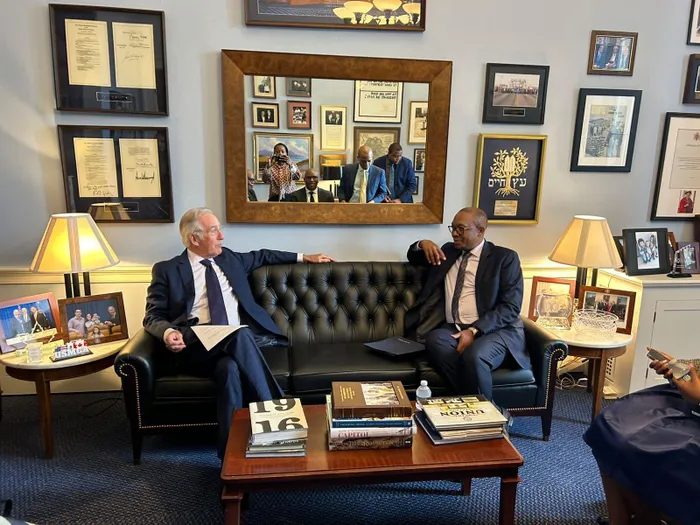Navigating Trade Challenges: South Africa's Economic Future Post-AGOA

Minister of Trade, Industry and Competition Parks Tau (right) met with US Congressman Richard Neal on September 9 in New York. The meeting was part of Tau's lobbying efforts with US stakeholders regarding bi-lateral trade relations between the two countries.
Image: X
Zamikhaya Maseti
The latest trade statistics released by the South African Revenue Service (SARS) on 30 September 2025 reveal a paradox at the heart of the national economy. In August, South Africa posted a preliminary trade surplus of R4.0 billion, with exports at R171.3 billion against imports of R167.4 billion.
On the surface, this surplus reflects resilience in the face of global turbulence, evidence that the economy can still absorb shocks and generate momentum. Yet the figures also reveal fragility: exports declined by 6.8 per cent compared to the previous month, while imports increased by 1.9 per cent.
Gold, aluminium, and diamonds declined, even as imports of aeroplanes, data-processing machines, and components increased, underscoring South Africa’s persistent dependence on foreign technology. The surplus holds, but only on precarious ground.
In an effort to maintain South Africa’s resilience, Minister Parks Tau, the Minister of Trade, Industry, and Competition (DTIC), has demonstrated commendable resolve in confronting the turbulence unleashed by Trump’s conservative Republicanism. His tireless engagements with U.S. trade officials demonstrate both urgency and commitment, as he seeks to safeguard South Africa’s economic interests in a hostile environment. By working to preserve the country’s foothold in the American market, he is carrying a heavy responsibility with diligence and determination.
Since Donald Trump’s Conservative Republicanism returned to the White House, the world economy has entered a period of turbulence. His doctrine of reciprocal tariffs, designed to punish trade partners with preferential access to U.S. markets, has unsettled multilateral norms and destabilised global commerce. South Africa was not spared, drawn into the crossfire of Trump’s Conservative Republicanism from which there was no easy escape.
Trump’s tariffs strike at the heart of South Africa’s industrial base. The automotive industry has employed more than 100,000 workers directly and sustains many more through extended value chains. It also anchors South Africa’s manufactured exports.
Tariffs have eroded the competitiveness once secured under the African Growth and Opportunity Act (AGOA). The August decline in exports is an early symptom. Should this continue, factories will scale down and jobs will disappear.
The expiry of AGOA on 30 September 2025 deepens the uncertainty. South Africa waits for clarity on whether Washington will extend or terminate the agreement. The Trump administration has remained deliberately opaque. This lack of certainty discourages investment and undermines confidence in sectors that depend on U.S. market access.
For South Africa, AGOA has always been more than a trade mechanism. It represented goodwill after Apartheid and served as a lever for industrialisation. Its collapse would signify a rupture in relations without an immediate alternative.
To navigate this crisis, South Africa must reconfigure its automotive strategy with urgency. Fifteen Chinese car brands already operate in the country, but most ship finished vehicles rather than assemble or manufacture locally. This drains foreign currency, stunts industrial development, and constrains job creation.
South Africa must transition from being a passive market for imports to an active hub of production. The path ahead is clear but demanding. First, secure full assembly of these brands domestically, creating jobs and stabilising supply chains.
Second, transition to full-scale manufacturing of engines, gearboxes, and other key components, capturing value that currently leaks abroad. By localising production, South Africa can reduce dependence on imports and strengthen resilience against external shocks.
China is well placed to provide this partnership. Its automakers possess capital, technology, and the appetite to expand globally. South Africa offers both the market and the industrial infrastructure. A structured collaboration could anchor the sector while positioning the country as a continental hub under the African Continental Free Trade Area.
Minister Parks Tau alone cannot shoulder the responsibility. Mercedes-Benz and other Original Equipment Manufacturers (OEMs) with deep roots in South Africa must be drawn into his offensive. They must protect their local operations while aggressively exploring alternative markets across Africa and within the BRICS bloc. BRICS partners, for their part, must show solidarity with South Africa and support its efforts to withstand unilateral shocks.
This moment demands bold innovation, a carefully orchestrated tactical and strategic manoeuvre to realign South Africa’s trade posture in a volatile global order, while also fending off the AGOA domino effect with vigilance, for it is better not to lower the guard.
South Africa must negotiate a strategic pact with Chinese automakers to localise production, establish a national automotive economic zone with strong incentives, enforce domestic content targets, mobilise finance for suppliers, and leverage AfCFTA as a gateway to the African Continent.
It must also encourage OEMs already embedded in the economy to align with this strategy and diversify markets. Only through such collective action will South Africa transform its fragile trade surplus into a durable industrial advantage, securing the economy against decline and insulating its people from the shocks of an unforgiving global order.
* Zamikhaya Maseti is a Political Economy Analyst and holds a M.Phil in South African Politics and Political Economy from Nelson Mandela University.
** The views expressed do not necessarily reflect the views of IOL, Independent Media or The African.